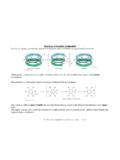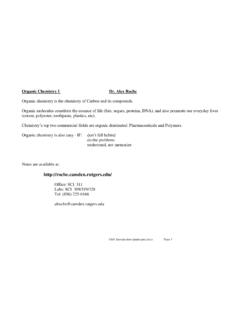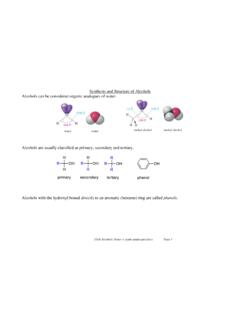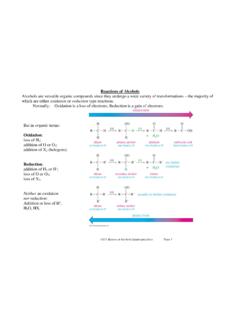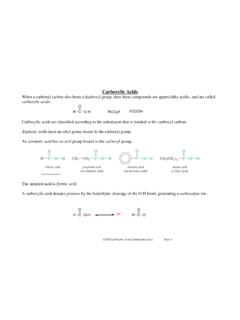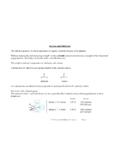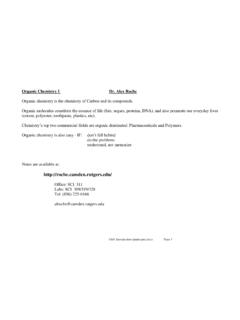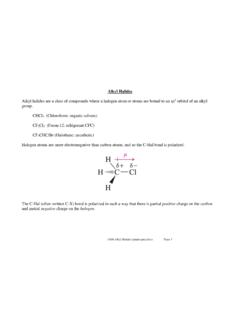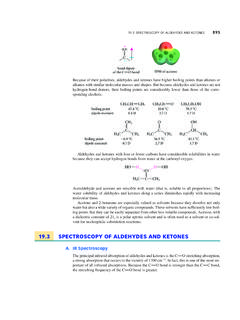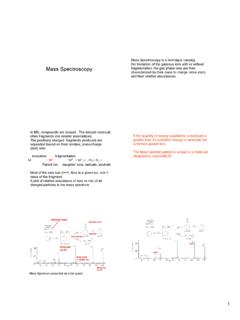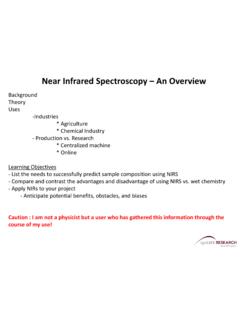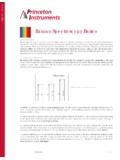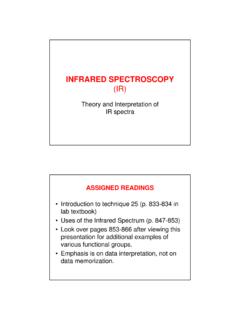Transcription of Infrared Spectroscopy and Mass Spectrometry
1 Infrared Spectroscopy and mass Spectrometry Introduction It is fundamental for an organic chemist to be able to identify, or characterize, the new compound that he/she has just made. Sometimes this can be achieved by a chemical means, such as determining the elemental composition and molecular weight. If the compound has been made previously, it is possible to compare physical properties (boiling points / melting points, etc ) with literature values. Chemical tests can be used to determine whether certain functionalities are present or absent.
2 But, these are not sufficient for either complex molecules or new molecules that have never been made before. Tests can be either destructive or non-destructive. (Combustion which gives elemental analysis is destructive, whereas NMR is non-destructive - you can recover your sample). Ideally, chemists want techniques that use small amounts of compounds, are non-destructive, quick and give unambiguous results. Spectroscopic techniques generally meet almost all of these requirements. The four most common are: Infrared Spectroscopy (IR Spectroscopy observes the vibration of bonds, and gives information about which functionalities are present).
3 mass Spectrometry (MS provides information concerning the mass of the molecule, and sometimes about its structure). Nuclear Magnetic Resonance Spectroscopy (NMR Spectroscopy provides information about the numbers and environments of all the hydrogens (and Carbons and Fluorines) in a molecule. Probably the most important technique). Ch12 IR and MS Page1 Ultra Violet Spectroscopy (UV Spectroscopy deals with electronic transitions, and gives information mainly about multiple bonds and conjugation). The Electromagnetic Spectrum Visible, IR and UV light, microwaves and radio waves are all examples of electromagnetic radiation.
4 They all travel at the same speed (the speed of light, 3x108m/s), but differ in their wavelength and frequency. The frequency, , is the number of complete wavecycles to pass a fixed point in one second. (Usually in Hz, which means cps). The wavelength, , is the distance between any two peaks of the wave. Diagram 12-2 Wavelength and frequency are inversely proportional. = c/ where c is the speed of light. Electromagnetic waves travel as photons, which are packets of energy of zero mass . The energy of a photon is the product of its frequency and Planck's constant.
5 E = h H= Planck's constant kcal-sec Ch12 IR and MS Page2 Under certain conditions, when a photon of correct energy strikes a molecule, it can be absorbed and this leads to reaction. This is why we write photochemical reactions involving h . The electromagnetic spectrum covers all possible frequencies, ranging from radio waves that are low energy and cause nuclear spin transitions, up to X-rays that are of high energy and cause ionization of molecules. The Infrared RegionInfrared radiation is of slightly shorter frequency than visible light.
6 Typical IR wavelengths range from 8x10-5 cm to 1x10-2 cm, and this corresponds to energies of around 1-10 kcal. This energy is sufficient to make atoms vibrate, but not enough to cause electronic transitions. These vibrational transitions correspond to specific energies, which give rise to specific absorptions. Therefore, IR provides information about how atoms are bonded together. The position of an IR band is specified by its wavelength, measured in microns ( m = 10-6 m). Although more commonly, the term wavenumber is used, (nu bar) the reciprocal of the wavelength in cm.
7 Eqn 12-3 Ch12 IR and MS Page3 molecular VibrationsA covalent bond between two atoms can be envisaged as a spring holding them together. If the bond is compressed, there is a restoring force which pushes the atoms apart, back to the equilibrium bond length. Similarly, if the bond is stretched, there is a restoring force that forces the atoms back closer together, again restoring the equilibrium bond length. The frequency of the stretching vibration depends on two factors: (1) The mass of the atoms (2) The stiffness of the bond Heavier atoms vibrate more slowly than lighter ones, so a C-D bond will vibrate at a lower frequency than a C-H bond.
8 Stronger bonds are stiffer than weaker bonds, and therefore require more force to stretch or compress them. Thus, stronger bonds generally vibrate faster than weaker bonds. So O-H bonds which are stronger than C-H bonds vibrate at higher frequencies. Table 12-1 (SLIDE) The IR spectra of even simple molecules contain many different absorptions (not just one for each bond). These absorptions result from not only the stretching of the molecule as a whole, but also from bending vibrations. In general for a non-linear molecule containing n atoms, there are 3n-6 fundamental vibrational modes.
9 Ch12 IR and MS Page4 Ch12 IR and MS Page5 Consider the water molecule (non-linear, 3 atoms 3 fundamental vibrational modes). Figure 12-2 These are only the Fundamental vibrational modes, these can combine and multiply to give rise to numerous other modes of vibration. These more complicated modes give rise to the numerous absorptions in an IR spectra, and since different molecules will have different IR spectra, we can use IR to help identify molecules. The most complex (and informative) region is called the fingerprint region (600-1400cm-1) , and this contains the wagging, twisting, scissoring and rocking vibrations.
10 The region that contains the simple stretching vibrations is typically from 3500 to 1600cm-1, and this is the area we will focus our studies on. IR Active and IR Inactive Vibrations Not all molecular vibrations absorb IR radiation. To understand which ones do (and which do not) absorb we need to consider how an electromagnetic field interacts with the chemical bond. Important points are: (1) A chemical bond which is polarized has a dipole moment ( charge separation). (2) An electric field will interact with the polar bond, causing it either to stretch or compress.
